Software-Defined Hardware: Why the Future of Hardware is Software-First
The Shift Toward Software-Defined Hardware
For decades, hardware innovation was driven by improvements in materials, manufacturing techniques, and supply chain efficiencies. But today, the most valuable hardware companies are not just selling physical products—they are monetizing software layered on top of their devices.
The shift toward software-defined hardware (SDH)—where software controls, enhances, and extends the functionality of physical products—is reshaping industries from consumer electronics to industrial automation. Apple, Tesla, and Nvidia are prime examples of companies leveraging software-first strategies to maximize margins, drive recurring revenue, and create defensible moats.
For investors, this model represents a massive opportunity: startups that adopt software-first principles in hardware markets can unlock new business models, improve gross margins, and avoid the pitfalls of commoditization.

Why Software-Defined Hardware Matters
Traditional hardware businesses face several challenges:
High manufacturing costs and capital intensity.
Margin compression due to commoditization and competition.
Long product development cycles with limited flexibility post-production.
By contrast, software-defined hardware companies gain critical advantages:
- Higher Margins – The ability to charge for software subscriptions or unlock new features post-purchase increases lifetime customer value.
- Continuous Innovation – Software updates allow companies to improve products after they leave the factory.
- Network Effects & Data Flywheels – The ability to collect and act on user data enables better personalization and retention.
Who is Leading the Charge?
Apple has mastered the hardware-software-service ecosystem, using iPhones, Macs, and wearables as delivery mechanisms for high-margin software products such as iOS, the App Store, and iCloud. The company’s services revenue hit $85 billion in 2023, significantly outpacing hardware growth. Apple’s strategy is clear: build premium, tightly integrated hardware and monetize software through app ecosystems, cloud services, and subscription models like Apple One. By controlling both hardware and software, Apple ensures that every device sold acts as a long-term revenue driver, rather than a one-time purchase.
Tesla has redefined automotive hardware by treating cars like computers on wheels. Instead of selling features as fixed physical components, Tesla monetizes over-the-air (OTA) software updates and autonomous driving subscriptions. Features such as Full Self-Driving (FSD) mode, improved battery performance, and user interface updates are continuously rolled out through software, extending the lifespan and value of each vehicle. The result? Tesla’s software-driven model gives it gross margins exceeding 20%, while traditional automakers struggle with single-digit margins and face declining hardware differentiation.
Nvidia’s dominance in AI chips is not just about superior silicon—it’s about software. CUDA, its proprietary software ecosystem for GPU computing, has locked developers into its platform for AI, gaming, and high-performance computing. Rather than competing purely on hardware specs, Nvidia differentiates itself through proprietary AI models, developer tools, and ecosystem lock-in, ensuring sustained demand for its chips. As AI workloads increase, Nvidia’s deep integration of software and hardware makes it indispensable to the industry, allowing it to capture more value per unit of hardware sold.

Apple’s Secure Enclave Software Chip
The Next Wave: Where Investors Should Look
Several emerging categories are primed for software-defined hardware disruption:
AI-Powered Consumer Devices – AI PCs, smart glasses, and wearables will shift toward real-time, on-device intelligence that can be continuously upgraded via software.
Smart Manufacturing & Industrial Automation – Robotics and automation companies are embedding AI-powered software layers to improve factory productivity, predictive maintenance, and autonomous decision-making.
Healthcare & Medical Devices – Startups are leveraging software to personalize treatments in areas like neuromodulation, at-home diagnostics, and robotic surgery, with cloud-connected, updateable hardware.
Cybersecurity for Hardware-Driven AI – As AI hardware proliferates, companies will need software-driven security layers to protect edge devices and prevent data breaches.
What’s Next for the Industry?
As software-defined hardware becomes the dominant model, venture investors should focus on startups that monetize software-first while maintaining hardware defensibility.
The key questions for evaluating opportunities:
- Does the company have a recurring revenue model (SaaS, licensing, or software subscriptions)?
- How does software enhance or differentiate the hardware product?
- Can software updates extend the product’s lifespan, improving retention and margins?
Companies that blend hardware innovation with scalable, high-margin software models will define the next generation of tech giants.
For investors, backing software-first hardware companies today is like investing in SaaS in the early 2010s—the biggest winners will be those who recognize the shift before it becomes mainstream.
—————————————–
If you are a builder, investor or researcher in the space and would like to have a chat – please reach out to me at amit.k@thelotuscapital.com
